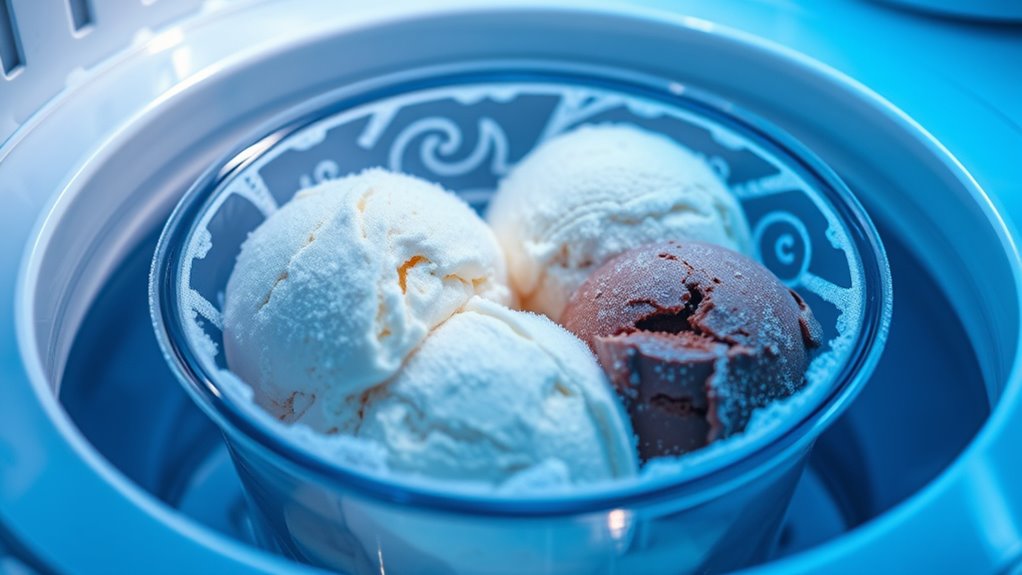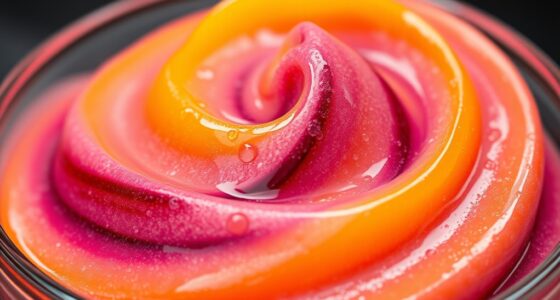To keep your ice cream at its best, set your freezer to around -6°F (-21°C). This temperature helps maintain a smooth, scoopable texture by preventing large ice crystals and slowing sublimation, which can cause freezer burn. If it’s too cold, the ice crystals get bigger, affecting creaminess. If too warm, the ice cream softens or melts. For reliable results and tips on proper storage, continue exploring these essentials.
Key Takeaways
- The ideal freezer temperature for ice cream is around -6°F (-21°C) to maintain firmness and prevent large ice crystals.
- Proper temperature slows sublimation, reducing freezer burn and preserving ice cream flavor over time.
- Temperatures above -6°F can cause ice cream to become soft and melt easily.
- Temperatures below -6°F may lead to larger ice crystals, resulting in a gritty texture.
- Using a freezer thermometer ensures accurate temperature control for optimal ice cream storage.

If you want your ice cream to stay creamy and scoopable, setting your freezer to the right temperature is vital. Proper ice cream storage depends heavily on maintaining an ideal freezer temperature, typically around -6°F (-21°C). When your freezer is too cold, ice crystals can form larger, making the ice cream gritty and less enjoyable. Conversely, if it’s too warm, the ice cream can become soft, melt quickly, and develop freezer burn, which compromises both texture and flavor. Finding that perfect balance ensures your ice cream remains in prime condition.
The ideal freezer temperature for ice cream storage isn’t just a random number; it’s a carefully chosen setting that preserves the quality of your frozen treat. Most household freezers are set around 0°F (-18°C), which is suitable for most foods, but for ice cream, slightly colder temperatures are better. Setting your freezer to about -6°F (-21°C) helps keep the ice cream consistently firm without risking excessive ice crystal growth. This temperature prevents the formation of large, coarse ice crystals that ruin the smooth texture you crave in good ice cream. It also helps slow down the sublimation process, where ice turns directly into vapor, which can cause freezer burn and dry out your treat. Using a freezer thermometer is essential to accurately monitor and maintain this temperature, ensuring consistency over time.
Adjusting your freezer temperature is simple but vital. Many freezers have a dial or digital control, so check the settings and aim for that -6°F mark. Use a freezer thermometer to verify the actual temperature, as built-in indicators can be inaccurate. Once set, keep the freezer door closed as much as possible to maintain consistent temperatures. Frequent opening causes temperature fluctuations, leading to ice crystal growth and uneven freezing, both of which harm ice cream quality.
Additionally, proper ice cream storage involves more than just temperature. Store ice cream in airtight containers to prevent moisture loss and absorb odors from other foods. Wrapping the container tightly and placing it near the back of the freezer, where temperatures are most stable, will help maintain ideal conditions. Remember, good ice cream storage isn’t just about keeping it cold; it’s about maintaining a consistent environment that preserves its creamy texture and flavor.
Frequently Asked Questions
How Often Should I Defrost My Freezer for Optimal Ice Cream Storage?
You should defrost your freezer when you notice a buildup of ice, usually every 6 to 12 months. Regular defrosting helps maintain proper freezer organization and prevents ice from damaging your storage containers. By keeping your freezer clear of excess ice, you guarantee consistent temperature, which keeps your ice cream in top condition. Remember, a well-maintained freezer makes it easier to organize your storage containers and preserve your favorite treats.
Does the Type of Ice Cream Affect the Ideal Freezer Temperature?
Imagine your freezer as a diligent guardian, keeping your ice cream varieties in pristine harmony. Yes, the type of ice cream influences the ideal temperature—denser, creamier varieties need colder settings, while lighter ones prefer a slightly higher temp. Using proper storage containers also helps maintain consistency. You should aim for around -20°C, ensuring each scoop stays smooth and flavorful, regardless of your ice cream’s unique character.
Can Fluctuating Freezer Temperatures Harm My Ice Cream’S Texture?
Fluctuating freezer temperatures can definitely harm your ice cream’s texture. When your freezer isn’t efficient or experiences temperature swings, ice crystals can form unevenly, leading to ice cream spoilage and a grainy, less creamy consistency. To keep your ice cream perfect, maintain a steady temperature and guarantee your freezer runs efficiently. This helps prevent spoilage and preserves that delightful, smooth texture you enjoy.
What Is the Best Way to Store Homemade Ice Cream?
You should store homemade ice cream in airtight ice cream packaging to prevent freezer burn and maintain freshness. Keep it organized in your freezer, placing it on a flat surface to avoid accidental damage. Use a freezer thermometer to monitor the temperature, ensuring it stays consistently cold. Proper packaging and freezer organization help preserve your ice cream’s texture and flavor, giving you delicious scoops every time you enjoy your homemade treat.
How Do I Prevent Ice Crystals From Forming in My Ice Cream?
To prevent ice crystals from forming, you need to focus on proper air circulation and storage containers. Keep your ice cream covered tightly to block air exposure, and use airtight containers to minimize moisture. Regularly check your freezer temperature to make certain of consistent cold. Stir the ice cream during freezing if possible, and avoid frequent opening, which disrupts air circulation. These steps help maintain smooth, creamy ice cream without unwanted ice crystals.
Conclusion
So, as much as you might wish your freezer could magically keep your ice cream perfect all the time, it’s up to you to set it just right. Ironically, in trying to prevent melt-downs, you might actually be spoiling the fun. Remember, a tiny tweak in temp can make all the difference between a scoop that’s sublime or a scoop that’s sad. Keep it cool, literally—your ice cream will thank you, even if your freezer doesn’t.










